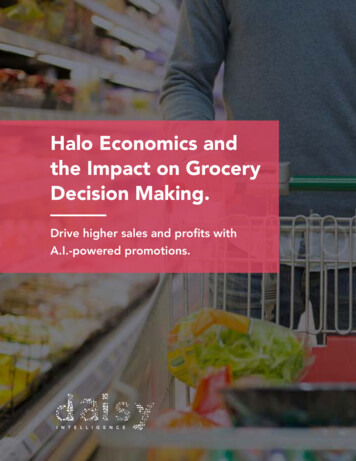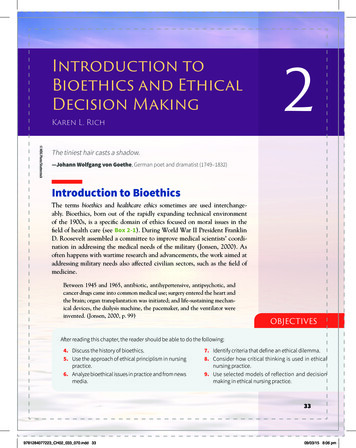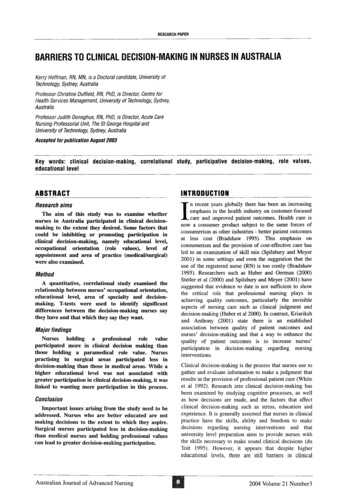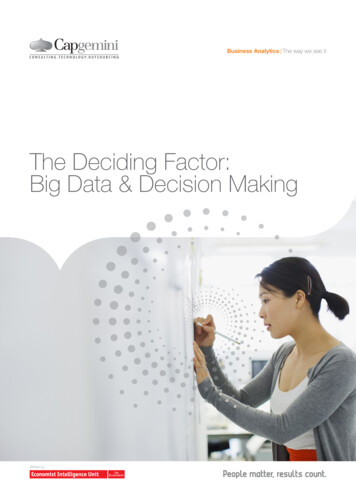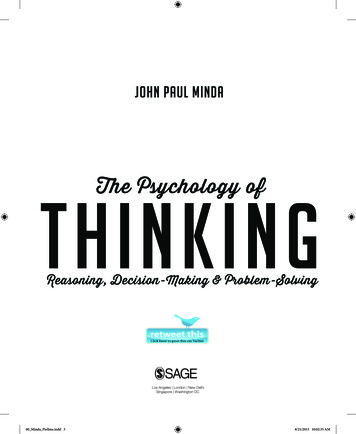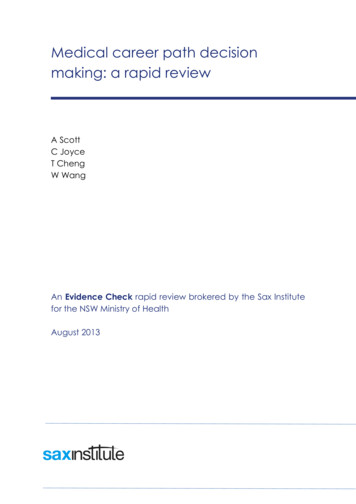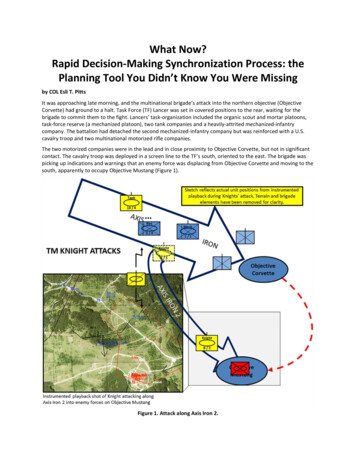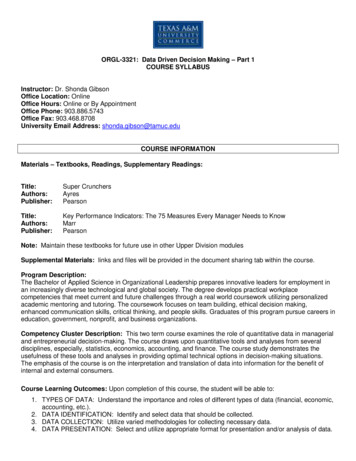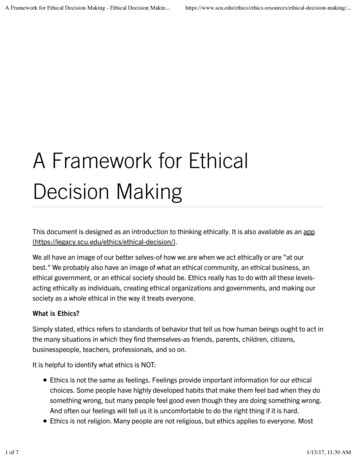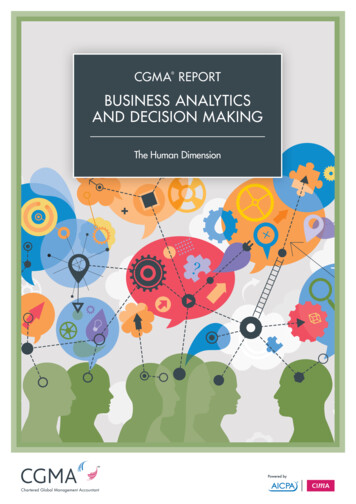
Transcription
CGMA REPORT BUSINESS ANALYTICSAND DECISION MAKINGThe Human Dimension
2BUSINESS ANALYTICS AND DECISION MAKING – THE HUMAN DIMENSIONChartered Global Management Accountant (CGMA )Two of the world’s most prestigious accounting bodies, AICPA and CIMA,have collaborated to establish the Chartered Global Management Accountant(CGMA ) designation to elevate and build recognition of the profession ofmanagement accounting. This international designation recognises the mosttalented and committed management accountants with the discipline and skill todrive strong business performance. CGMA designation holders are either CPAswith qualifying management accounting experience, or associates or fellowmembers of the Chartered Institute of Management Accountants.www.cgma.org
BUSINESS ANALYTICS AND DECISION MAKING – THE HUMAN DIMENSION 1CONTENTS1. Introduction22. Dimensional analysis43. Real-world analytics – case studies74. Challenges in working with data145. Implications for management accountants156. Business Analytics – Lessons learned177. Conclusion198. References20
2BUSINESS ANALYTICS AND DECISION MAKING – THE HUMAN DIMENSION1. INTRODUCTIONThe importance of decision makingGlobalisation means businesses across the worldhave access to similar resources, including materials,components, products and even people. As businessesalso use similar technologies, competition is causingbusiness processes to converge towards similarstandards. This is leaving the quality of a business’sdecision making as its main means for out-performingits competitors.Digitisation, meanwhile, is driving down costs andcausing commoditisation. Intangibles enable a businessto differentiate from its competitors. They are alreadythe main drivers of the value that a business cancreatei. The quality of its decision making enables abusiness to adapt more swiftly than its competitors tothe opportunities and threats presented by the digitalage and the developments in its markets. It is also thekey intangible that unlocks the potential to developother intangibles within the business, such as itscompetitive position, its brand’s reputation, thequality of its people, its intellectual capital and howwell it implements its decisions.Businesses must therefore address the risk of biasin decision making by ensuring that their decisionmakers do not unnecessarily exercise personaljudgement based on past experience or swayed bypersonal motives. Instead, they should aim to bemeasured and rational. Decisions should be basedon evidence provided by relevant information andon diligent analysis with a focus on stakeholder value.There should also be transparency and accountabilityin decision making to encourage a culture of sharedobjectives and mutual trust, fully consistent with theGlobal Management Accounting Principles2.Personal opinions and hunches are still importantbut they should be considered in the context of whatthe data now available tells us. Artificial intelligencecan generate algorithms and identify correlations, butthere is still a need to add this human dimension togenerate insights.The evolving role of the managementaccountantThe role of the management accountant is changingto provide better support for decision making andperformance management. The production ofstandard reports (such as end-of-month financials,variance analysis, KPIs and regulatory filings) isbecoming ever more automated. At the same time,due to the competitive environment, demand isgrowing for management accountants to provideongoing ‘insight’, not from financial data on its ownbut in combination with non-financial data as well,both internal and external to the business andsometimes including ‘big data’3.
BUSINESS ANALYTICS AND DECISION MAKING – THE HUMAN DIMENSION Unfortunately, many people have sought to overcomethe challenges associated with data and analytics inthe mistaken belief that, with the right technology,new insights and better decisions are almost a given.Yet analytics actually has very little to do withtechnology. Yes, there might be technical issues toaddress, such as getting access to data, combiningdata sets or integrating financial data with datagenerated from social media or ‘connected things’.However, no analytical tool can do more thanaugment or complement what is a cognitive andsometimes social process. Generating insight is aninherently human trait.It is people, not technology, who make senseof data and give it meaning. This means thatbusiness intelligence resides not in the datawarehouse but in the minds of people.The recent CGMA report – Joining the dots: Decisionmaking for a new era 4 – highlighted how many companiesare struggling to translate data into insight and buildthe decision-making skills of their senior leaders.Management accountants are ideally positioned tohelp a company focus on gaining insight from data.While many organisations are likely to have pocketswhere analytics is already taking hold, accountants’overview across the organisation and their focus onfinancial performance enable them to bring an objective‘big picture’ perspective. However, there is a dangerthat they could forfeit this privileged position unlessthey go about it in the right way. This report seeks toprovide guidance.“We held a recent roundtable of CFOs of USpublic companies and found that “adding insightto the numbers” was in the top three issues theyfelt were most urgent. They cited competitionand business model shifts as the drivers fordata-driven analytics across their business unitsand the need for their management accountantsto play a lead role in these efforts.”Tom Hood, CPA, CITP, CGMA,Maryland Association of CPAs andthe Business Learning Institute3
4BUSINESS ANALYTICS AND DECISION MAKING – THE HUMAN DIMENSION2. DIMENSIONAL ANALYSISDefinitions‘Dimensional analysis’, ‘business analytics’ or‘segmentation analysis’ are terms used to describehow business analysts and management accountantslook at data from various directions. This means theycan analyse performance by dimension – such as byproduct, by process, by customer segment or bydelivery channel. The objective might be to betterunderstand performance in terms of what hashappened, or why, or to identify what might happenor how to improve performance. It often involvesconstantly looking for incremental improvements orinnovations to ensure the business’s resources aredeployed where the returns or prospects are best.Business analytics aims to generate knowledge,understanding and learning – collectively referred toas ‘insight’ – to support evidence-based decision makingand performance management. As an umbrella termfor an evolution that began many years ago, it refers tothe competencies, processes, technologies, applicationsand practices involved in achieving these objectives.However, people can be confused by the overlappingof concepts and terms with seemingly similar meanings,sometimes intentionally driven by technology vendorsand others with vested interests. (See box opposite forguidance on some of the most common terms.)Decision making in businesses today is moving to thepoint where accepted practice is about first understandingthe numbers and what they are revealing, and thenusing this insight to drive intelligent business decisions.This replaces the approach where people take theaction that feels right and then examine the numbersafterwards to see if it worked. Insight, therefore,should drive decision making. But insight also has abroader role to play in the landscape of organisations.The types of questions that can beaddressed by analytics initiatives1. WHAT happened (descriptive)?This question seeks information describing asituation, event or the status of an asset or product(such as location or temperature) to set out what hashappened. For a law firm, for example, this mightinvolve reporting client revenue for the last quarter.‘What’ questions are usually answered in canned(or pre-defined) reports?2. WHY did it happen (diagnostic)?This aims to enable understanding of the reasonswhy an observed event actually took place. It mightnecessitate undertaking some root-cause analysis orusing data to test a hypothesis. For example, if a lawfirm is experiencing reduced billings with a particularclient, it is about understanding the reasons in orderto work out how to reverse the decline (i.e., to make adecision).3. WHEN might it happen (predictive)?The task here is to understand how to predict when afuture event is likely to happen. This will generallyrequire building a model. First, the component partswill need to be identified, before determining fromhistorical data how they all fit together. Historicaldata can then be used to see if the model is a goodpredictor of outcomes that have already been observed.For example, Rolls-Royce has collected petabytes(one thousand million bytes) of telemetry data on theperformance of its aeronautic engines. It can nowexamine this data to predict the likelihood of certaincomponents failing and schedule maintenanceaccordingly. On a smaller scale, a retailer might seekto predict the additional sales generated by particulartypes of promotions.
BUSINESS ANALYTICS AND DECISION MAKING – THE HUMAN DIMENSION 4. HOW I can make it happen (prescriptive)?Jargon busterThe main challenge in predicting events is often increating the mechanism through which people orevents might be influenced. This is usually achievedthrough experimentation. For example, online retailersmight do A/B testing (comparing the performanceof two versions of a web page) to determine whichdesign is most likely to convert visits to real sales.A mobile phone operator might wish to nudgecustomers towards using channels that cost less toservice. Or a tax authority might want to find outwhether a particular form of words in a tax demandmore effectively influences taxpayers to pay theiroutstanding liabilities on time.Business analytics is an evolution of a practice thatin the early 1970s was called decision support systems(DSS)5. However, in some organisations, businessanalytics is used interchangeably with businessintelligence (BI) (although, confusingly, analyticsis often seen as a subset of BI). Other terms alsooverlap with analytics – here are a few of them:Rational decision makingDecision making is often presented as a rational process,in which individuals make decisions by collecting,integrating and analysing data in a coldly rational,mechanistic way. However, research has long shownthat this is not how people make decisions. Decisionmaking is a dynamic, contextual and personal/groupactivity in which prior knowledge and experience arerecalled and combined with information.Most organisations rely on individuals to make rationaljudgements that are based on data. Yet outcomes frompsychological experiments exploring this area suggestthat people will frequently fail to do so. What is reallyinteresting is that they fail to do so in systematic,directional ways that are predictable6.In addition, evidence has been accumulating sincethe 1950s that the individual’s ability to handle largevolumes of data is limited.7 So it is by no meansguaranteed that providing large amounts ofinformation enables better decisions to be made orgenerates insight. One study found that decisionmakers may not use IT tools to increase their use ofinformation and so improve the quality of theirdecisions.8 Instead, they may use technology to reducethe amount of mental effort needed to make decisions.Other studies have found that managers often lackawareness of the existence and relevance of the manydiverse and often dispersed data sources available tothem. They have also pointed to the social aspects ofdecision making as reasons why information and ITare not always used in ‘rational’ ways. 9Business performance management (BPM): anapproach that allows the monitoring, measurementand comparison of key performance indicators (KPIs).Data mining: a computational process ofdiscovering patterns in large data sets. It involvesusing methods at the intersection of artificialintelligence, machine learning, statistics anddatabase systems.Data science: an interdisciplinary field concernedwith the processes and systems used to extract insightsfrom data. It is a continuation of other data-analysisfields including statistics, data mining andpredictive analytics.Data warehouse: a large repository of organised data.Extract transform load (ETL): a process in datawarehousing responsible for extracting data fromthe source systems and placing it into a datawarehouse.Machine learning: a method of data analysis thatautomates the analytical model-building process.Using algorithms that iteratively learn from data,machine learning allows computers to find hiddeninsights without being explicitly programmed onwhere to look.Meta data: the tagging of data, providing adescription for the purposes of managementand analysis.Online analytical processing (OLAP): themultidimensional analysis of business data, providingthe capability for complex calculations, trend analysisand sophisticated data modelling. It is oftenseen as part of the broader category of businessintelligence, which also encompasses the relationaldatabase, report writing and data mining.Predictive analytics: a process that attempts tomake predictions about unknown future eventsusing techniques including data mining, statistics,modelling, machine learning and artificialintelligence to analyse current data.5
6BUSINESS ANALYTICS AND DECISION MAKING – THE HUMAN DIMENSIONBias in decision makingPeople also have individual biases (see box below).As well as carrying their own personal assumptions thatinfluence their thinking processes, they have cognitivefilters that shape how they interpret information andrespond to cues.10 Furthermore, people’s responsivenessto environmental signals means that their decisionmaking, particularly at senior management level, tendsto be more driven by events and issues than systematicand evidence-based. ‘Gut f
decision making as reasons why information and IT are not always used in ‘rational’ ways.9 Jargon buster Business analytics is an evolution of a practice that in the early 1970s was called decision support systems (DSS)5. However, in some organisations, business analytics is used interchangeably with business is often seen as a subset of BI .


